Having gone to bed early - partly because sunset was at quarter-to-five, but mostly because we're old-and-boring - I'd mentioned to @mrs.turbodb that we should also get up early because while the Nadeau Trail might only be 27 miles long, all of our side trips would mean a couple more packed days of adventure.
I'm not sure she ever agreed, but I set my alarm for 5:00am regardless. 
There was no color in the sky when I awoke, but the breeze was warm and inviting, so I climbed out of the tent and waited. Slowly, color. And a little more - or at least a touch more brightness - as I climbed to the top of an outcropping behind camp.
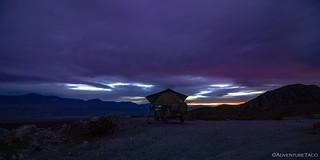
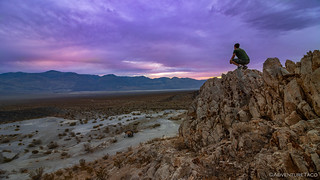
Even with no dramatic sunrise, I spent an hour just enjoying the peacefulness of the desert as the sun crested the horizon and started its trek through the cloudy sky. Plus, that gave @mrs.turbodb an extra bit of rest, a fact I'm sure that she too, appreciated.
Eventually I whistled as I made my way down and received a whistle back as she got dressed and out of the tent. Breakfast, packing up - all the usual stuff that we do in the morning followed - and we were out of camp nice and early, doing our best to take advantage of the short days that accompany bearable temperatures in the region.

Our first stop was the Panamint Valley Crater. Located in the alluvial fan of the Argus Range, this circular depression is unusual enough that the United States Navy dug a 130 foot shaft - the apparatus which still sits at its bottom - to ascertain its origin.

Unlike other craters, it shows no evidence of an impact or eruption - disturbed soil or a raised rim. Most likely then, this crater is an enormous sink hole - created when water eroded a large underground cave in the limestone that underlies the alluvial fan. Eventually, this came became too large to support the weight of the material above it and collapsed. With each passing year, the desert slowly continues to reclaim this hole, these Cotton Top Cactus doing their part to fill in just a bit of the void.

Pointing ourselves north once again on the Nadeau trail, we found this middle section of the Argus Range to be extremely stunning in the morning light. The striations of rock - both at the micro and macro levels - were glorious, and we must have stopped a handful of times to simply stare.


Well, before long we found ourselves at the intersection of the Nadeau Trail and the more modern Nadeau Road, which crosses in a northwesterly direction towards Revenue Canyon and the Panamint Valley Limestone. I'd not planned to explore this area, but when @mrs.turbodb read the description in Hiking Western Death Valley, we both decided that it was probably worth our time:
Revenue Canyon and Knight Canyon, its close neighbor to the south, drain the same slope of Maturango Peak and cut through the same formations. Expectedly, they are fairly similar. Both canyons start with a dramatic gorge, reach the plutonic core of the Argus Range, and eventually wiggle through narrows drained by a tiny creek. There are also manmade similarities—the road, the wilderness status, the mines and associated ruins. One of the appeals of this hike is the opportunity to gauge how well the mountain cloned these twins. The main differences are the ease of hiking and the mines—Revenue Canyon wins on both counts.
And with that, we headed west, our truck pointed squarely at the Panamint Valley Limestone mill.

It turns out that the activity at this quarry is a relatively recent re-activation of the site, the Diversified Minerals, Inc. company spending $45M in 2018 to begin a process that will produce four grades of Quick Lime and Hydrated Lime products to be used in cement, soil conditioning, water treatment and other industrial processes.

The site is private, so we observed from our side of the fence as we drove around and toward the lure of Revenue Canyon - a five mile hike into the varied pallette beckoning us forward.

I don't know if it was simply the brighter light of morning, or whether this portion of Revenue Canyon really was just a little more dramatic than Knight Canyon the previous evening, but even as we left the truck and set off on foot, I was already glad we'd opted to stop.

A little less than a half-a-mile up the wash, we came to the Big Four Mill where a large ore bin and four cyanide vats - along with a bunch of trash - are the easiest-to-enjoy points of attraction.

Across the wash - and up an extremely steep and narrow trail - are some of the the workings processed by this mill. A headframe and cableway tower are still visible, but we opted to skip them this time, given that this entire canyon hadn't been on our radar just 30 minutes earlier!
Instead, we headed up the wash, the trail meandering past a spring - this one with water still gurgling out of the ground.

We found the remnants of an old cabin at a fork in the canyon - its platform all that remained of what was surely a beautiful - if hard - place to call home.


Early 1960's style.
From the cabin, it wasn't far to the Copper King Mine, its tailings pile and mine shafts hard to miss along the side of the canyon. This area turned out to be quite interesting - and we spent some time exploring the shafts, picking through tailings, and climbing about on foundation of the old mill.



The elusive mint rock, crushed for mint chip ice cream. 

The canyon split once again - both sides heading up small marble dry falls - and we chose the fork to the right. Here, a juvenile Cotton Top cactus grew - seemingly - colorfully out of the rock.


This little guy was the size of a softball. Look closely at the strikingly green flesh protected by the threatening spikes.
Our desire to continue petered out a quarter mile or so further as we reached a dry fall that we'd envisioned as being grander than it ended up being. Overgrown with Rabbit Brush - something I'd had my fill of the evening before - we opted to retrace our steps to the truck and continue on our way.
The scenery in the canyon was equally dramatic on the way down as it had been on the way up!

Back on the Nadeau Trail, the battle between the sun and clouds was raging - the sun seeming to pull ahead as the morning wore on. But the lenticular clouds in the sky told us something altogether different - rain was on the way in the next day or two.
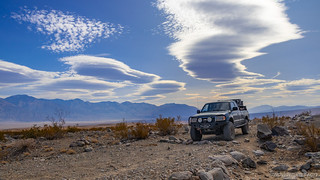
Our early start to the morning meant that we were both getting a bit peckish as we reached the road leading into Snow Canyon, and we decided it'd be the perfect place to stop for a lunch of tuna sandwiches - something we'd both been looking forward to since prepping the tuna a few days earlier. Unlike other roads into the Argus Range, this one was signed - sort of - and because the main road ended before the wilderness boundary, we were able to drive the entirety of its 7-miles to the three-level Snow Canyon Mill in right around half an hour.
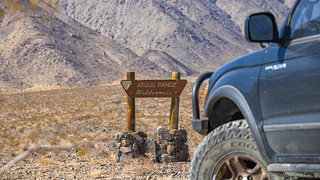


As @mrs.turbodb assembled sandwiches, I took a few minutes to climb around the mill - always a favorite activity when we come upon one of these beauties. While the Snow Canyon Mill has clearly seen better days, it was still quite remarkable to see the process that was used, each chute to a lower level, smaller than the last.

The crushing - which appeared to be grinding in this case - of the stone happened in relatively small bowls before dropping into the next chute, the large wheels powered by belts that would provide the necessary leverage to pulverize the gold-rich material with one of the best views around!

We enjoyed lunch with a similar view, though we sought shelter behind the truck as the wind started to whip up the canyon. Still, with the temperatures hovering between 75- and 80°F, the day was a splendid one to be sure.
As we ate, we discussed our next steps. You see, Snow Canyon is an explorer's paradise - while the mill at which we enjoyed lunch was cool, about a quarter mile back down the road, we had a decision to make. From there - the location of an amazing set of stone ruins from the Golden Lady Mine Camp - there were a plethora of choices. We could - of course - spend some time looking around the ruins. Or, should we so decide, we could tackle the roads to the St. George or Golden Lady mines. Both of these roads were described as "difficult," with rewards that were well worth it, even if it meant hiking instead of driving:
Deeply gauged and rocky, it is one of the most precipitous mining roads I have had the fortune to walk. From here to the rim of the canyon, it ascends 1,300 feet in 1 mile, and its steepest pitch tops the 40% mark!
That was enticing enough for us, and we took the fork to the Golden Lady Mine - the less difficult of the two roads. Except that less difficult was from 2009, and I'd now classify the road as impassable to all but foot traffic. Instead, the secrets of the two mines remained just that, and we spent a few minutes poking around the stone ruins of the mining camp before marking this spot as one to return to in the future - to hike!
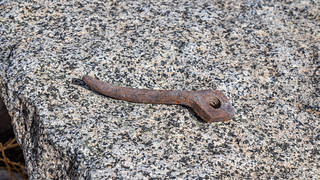
What is this slightly hooked spike I found at ruins of the Golden Lady Mining Camp? The hole appeared threaded.
Heading back down the canyon, the views into Panamint Valley were awesome, even with smoke from the Creek Fire in California's Sierras. I can only imagine how my breath would be taken away on a clear day from this same location.


A little further down the road, we passed the only other vehicle we'd see for the duration of our journey along the Nadeau Trail. A 2-door Jeep Wrangler, its occupants were a couple of old desert rats, looking for a spot to call home for the evening. Having grown up in the area, they seemed to know the road reasonably well and asked if there was anyone else camped along its length. With confirmation that there was not, we bid each other a fun time and continued on our way - back out to, and along the Nadeau Trail!



We had two more canyons to explore as part of our journey, both of them the ones I'd been looking most forward to as I'd planned the route. The first - Thompson Canyon - is home to the Minnietta Mine and cabin - a residence that's been maintained lovingly by its occupants over the years.

The Minnietta complex climbs high up the mountainside. We could have spent a day exploring just this area.
The silver and lead deposits of the Minnietta Belle Mine, as it was once known, were discovered in 1876. As much as 20 feet thick, the Minnietta's ore bodies turned out to be exceptionally rich with assays running as high as 200 ounces of silver per ton and 50% lead - with a little gold to boot. However, as was common in the area, the ore bodies seemingly ran dry and a few months later - in 1877 - production was so low that the mine was foreclosed.
Jack Gunn acquired the mine in 1883 and was the man who ultimately turned it around, working it for the next 32 years - continuously until 1905, then intermittently until 1915 - harvesting half a million dollars in silver and gold! The mine was worked on-and-off between 1916 and as late as 1991, with another 42,000 ounces of silver extracted by two miners from Trona alone. By the time the mine shut down 115 years after its discovery, over $1M dollars of material had been pulled from the ground.

The stars and stripes standing proudly at attention in the wind, we initially thought the cabin was occupied. Instead it seems, its previous visitors had simply forgotten to stow the flag before checking out.

The cleanest cabin I've seen. If you visit this cabin, be sure to show it the respect of those before you. A lot of work has gone into its maintenance.
Behind the mine, a steep 4wd trail winds up the mountain to a series of structures, relics, and even the lower terminal of its aerial tramway. The tramway's twin cables remained taught until as late as 1998, when the BLM finally cut them in order to relieve pressure on the aging structure.

The upper tramway terminal.

A gasoline hoist at the highest workings - where Jack Gunn worked this claim.

When a mine is worked into the 1990's, globalization plays a roll.
From the Minnietta, we continued up Thompson Canyon, stopping first at the Hughes claim - part of the Minnietta complex - where lead was produced in vast quantities between 1926 and 1940. In rough shape, only the mine shafts remain here - and even they are showing their age, wooden beams and support structures falling, graffiti disrespectfully sprayed along the walls.

Beyond the Hughes claim, the road continued for another mile or so, terminating at what is now a single, well-constructed, stone cabin. We found it a bit anti-climactic after all we'd just seen, though its location in the wash serves as a gateway to a hike that we'll need to return to on a future trip!


The wooden roof was still largely intact, though the inside of the cabin was a mess.
Having gotten an early start to the day, it was still a little before 2:00pm when we started back down the canyon towards the last segment of the Nadeau Trail - the segment that would lead us to the Modoc Mine.
It was at this point that I prematurely counted my chickens. You see, I'd hoped to camp not near the Modoc Mine, but at another location that a fellow explorer had discovered nearly a year earlier. With several hours still left in the day, I figured that we'd have no problem making a quick run up Stone Canyon, and then applying a good amount of skinny pedal to reach our camp site for the night.
Boy, I couldn't have been more wrong...
The Whole Story
Love Death Valley? Check out
the Death Valley Index
for all the amazing places I've been in and around this special place over the years.





Panamint trail/valley used to be quite the 4wheeling destination. I've still got some of the articles from the 90's on the trail in. I'd like to get down here and see that spot.
Thanks again...Day 2 was wonderful also. Enjoyed your adventure...Donna
Hello Turbodb
Funny that my search this morning for additional info on Revenue Canyon brought me here to your link and adventure to the Canyon. By the way, thanks again for the info on Backcountry Navigator, I'm looking forward to using it on my tablet, instead of using my Garmin Drivetrack71. Last month my wife and I were staying at Panamint Springs (one of many stays there in the past) and didn't quite make it to Revenue Canyon.
There was a lot on our list and we didn't know the trail was blocked by boulders near the limestone plant. We decided to turn around at the boulders and come back on another trip to hike into the canyon. We then headed over to Snow Canyon and spent the remaining part of the day there before heading back to camp.
At one time or another we've been to many destinations throughout the Panamint and Death Valley areas and always enjoy it very much. Now planning to go back next Spring. I'm Glad I found your link and enjoying reading about your adventures!
Welcome back! Glad to hear you found the trip report. Panamint Valley - and the entire series of canyons along the western edge - is just as spectacular in my opinion as those that lie in Death Valley to the east (and those that don't, hahahaha). So cool to wander around and see all the work that the old timers put in, usually for little or no results!
Enjoy your time out there - hopefully most of the park will be open by spring, because I'd like to get out there starting in January!